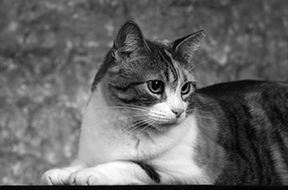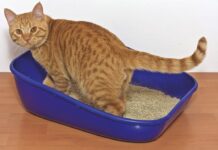Q. Our 6-year-old kitty, Elmo, has just been diagnosed with hypertrophic cardiomyopathy. This was a terrible shock to us, as he was not showing any signs of heart disease, and we want him to be around for a long time. We’ve been told that this is a common disease in cats, but we are terribly worried and want to know what we should be doing to keep him as healthy and happy as we can.

288
Sincerely,
Broken Hearted
A. I’m sorry to hear about Elmo’s diagnosis and glad that he is not showing any signs of heart disease right now. Hypertrophic cardiomyopathy (HCM), a disease characterized by thickening of the heart muscle, is the most common heart disease in domestic cats, and many cats diagnosed with HCM do not show symptoms of disease when they are diagnosed.
“It is pretty common for cats with HCM to be referred to a veterinary cardiologist for evaluation after their primary veterinarian hears a murmur during routine physical examination,” says Bruce Kornreich, DVM, Ph.D., DACVIM, the Associate Director of the Cornell Feline Health Center and a board-certified veterinary cardiologist.
HCM is diagnosed by echocardiography, and it is important to rule out high blood pressure and hyperthyroidism in cats with thickened heart muscle before arriving at a diagnosis of HCM, as these conditions can also cause thickening of the heart. Although HCM can be a very serious disease that can lead to congestive heart failure or the formation of potentially life-threatening blood clots, cats may live with HCM for prolonged periods of time (months to years) without overt signs of illness.
The cause of HCM remains to be determined, although mutations in a number of cardiac proteins have been identified in affected cats. Maine Coon cats, American Shorthairs and Ragdolls are predisposed to the development of HCM, and this disease affects male cats more commonly than females.
Cats with HCM may develop congestive heart failure, which may cause them to breathe more rapidly (tachypnea) and with more effort than normal (dyspnea), and any cat who shows signs of tachypnea or dyspnea should be taken to a veterinarian immediately. Another potentially devastating consequence of HCM is the formation of blood clots in the heart, which may be ejected out to the body and block blood supply to affected regions. The site of blockage is most commonly at the origin of the femoral arteries, which supply blood supply to the hind limbs, so cats who experience clot formation may present with acute, or sudden, onset of hind limb paralysis. These cats are often quite uncomfortable, and cats with clot formation generally have a poorer prognosis.
Cats with HCM may benefit from treatment with diuretics, drugs called angiotensin converting enzyme inhibitors and/or beta blockers, and cats who may be at risk for the development of blood clots may be treated with aspirin or a drug called clopidogrel (Plavix). Asymptomatic cats with HCM, however, are often not treated early in their disease, and careful monitoring of respiratory rate (normal is between 20 and 30 per minute), activity level, and attitude, as well as regular follow up with their veterinarian, are recommended in these cases.
I hope this helps you in understanding Elmo’s disease, and make sure to continue regular follow-up with his veterinarian. Please keep in touch and drop me a line to let me know how he is doing. ❖
Best regards,
Elizabeth



